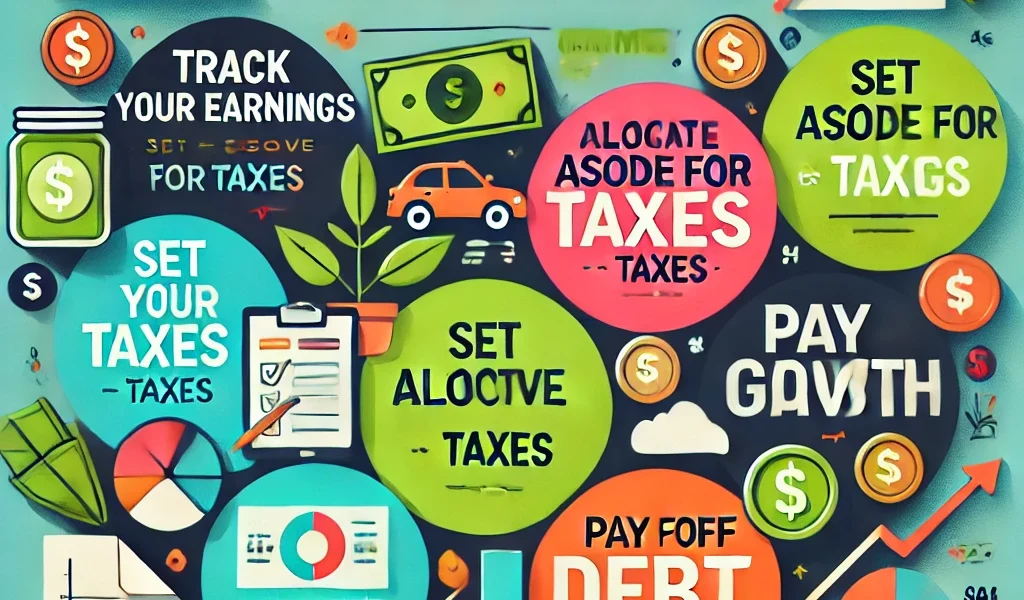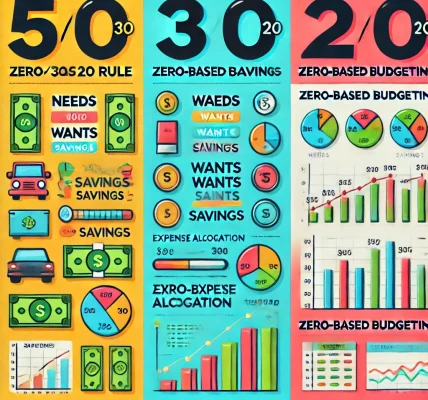📚 Introduction:
In today’s gig economy, having a side hustle has become a popular way to boost income, pay off debt, and achieve financial goals faster. Whether you’re freelancing, driving for a rideshare service, selling products online, or offering consulting services, a side hustle can provide extra income that enhances your financial security.
However, many people struggle to incorporate their side hustle income into their budgets effectively, which can lead to inconsistent saving, overspending, or even tax issues.
In this guide, we’ll explore how to successfully integrate your side hustle income into your budget while staying aligned with your financial goals and avoiding any legal pitfalls.
🎯 Why It’s Important to Include Side Hustle Income in Your Budget
Failing to account for side hustle income properly can create financial chaos. It’s essential to manage this income effectively for the following reasons:
✅ Achieve Financial Goals Faster: Use the extra income to pay off debt, build savings, or invest.
✅ Avoid Overspending: Prevent impulse spending by allocating side hustle income toward specific goals.
✅ Maintain Financial Organization: Track all sources of income to stay on top of your budget.
✅ Ensure Legal Compliance: Properly account for taxes and avoid legal troubles.
🚨 Pro Tip:
Treat your side hustle income like your primary income—allocate it purposefully rather than spending it as “extra” money.
📝 Step-by-Step Guide to Incorporating Side Hustle Income into Your Budget
🧾 Step 1: Track Your Side Hustle Income Consistently
The first step to incorporating side hustle income into your budget is to track all your earnings. Whether you’re receiving payments via direct deposit, PayPal, or cash, maintain a record of each transaction.
✅ How to Track Your Income:
- Use a dedicated spreadsheet to log each payment.
- Use budgeting apps like Mint, YNAB (You Need a Budget), or PocketGuard to automate tracking.
- Separate personal and side hustle accounts to make tracking easier.
🚨 Pro Tip:
Consistency is key. Make it a habit to record every payment, no matter how small.
💸 Step 2: Separate Side Hustle Income from Primary Income
It’s helpful to treat your side hustle income as a separate income stream until you decide how to allocate it.
✅ Why It’s Important:
- Helps prevent mixing extra income with regular income, making budgeting clearer.
- Allows you to assign a specific purpose to your side hustle earnings.
🚨 Pro Tip:
Open a separate account exclusively for your side hustle income to simplify tracking and allocation.
📊 Step 3: Decide How to Allocate Your Side Hustle Income
Once you have a clear record of your side hustle earnings, decide where that money should go. You can divide the income using a system that reflects your financial goals.
✅ Popular Allocation Methods:
- 50/30/20 Rule: Allocate 50% for needs, 30% for wants, and 20% for savings or debt repayment.
- Goal-Based Allocation: Assign a percentage of your side hustle income to different financial goals (e.g., 40% to debt, 30% to savings, and 30% for discretionary spending).
- Emergency Fund Allocation: If you don’t have an emergency fund, use 100% of your side hustle income to build one.
🚨 Pro Tip:
Be intentional about how you allocate side hustle income. Prioritize high-impact financial goals.
📝 Step 4: Budget for Taxes to Avoid Surprises
Many side hustlers forget to account for taxes and end up owing more than expected. Since side hustle income is considered self-employment income, you’re responsible for setting aside money for taxes.
✅ How to Budget for Taxes:
- Set aside 20-30% of your side hustle income for taxes.
- Consider paying quarterly estimated taxes to avoid penalties.
🚨 Pro Tip:
Use a tax calculator to estimate how much you should set aside for taxes based on your side hustle earnings.
💰 Step 5: Build an Emergency Fund or Pay Off Debt
Side hustle income provides an excellent opportunity to strengthen your financial safety net or accelerate debt repayment.
✅ How to Prioritize Savings or Debt:
- If you don’t have an emergency fund, allocate side hustle income to build one with at least 3-6 months’ worth of expenses.
- Use extra income to pay off high-interest debt faster and save on interest payments.
🚨 Pro Tip:
Set up automatic transfers to move a portion of your side hustle income to savings or debt payments.
📉 Step 6: Avoid Lifestyle Inflation
It’s tempting to increase your spending as your income grows, but this can derail your financial progress. Avoid lifestyle inflation by keeping your spending consistent and using side hustle income for wealth-building purposes.
✅ How to Avoid Lifestyle Creep:
- Pretend your side hustle income doesn’t exist and allocate it toward future goals.
- Create a ‘no-spend’ rule for discretionary purchases unless they align with your budget.
📝 Step 7: Review and Adjust Your Budget Regularly
Incorporating side hustle income requires ongoing adjustments to your budget. Schedule monthly reviews to evaluate how well your plan is working.
✅ How to Review Effectively:
- Check if you’re meeting your financial goals.
- Adjust allocation percentages if needed.
- Revisit your tax withholding to ensure compliance.
🚨 Pro Tip:
Use budgeting apps to automate reviews and identify trends over time.
🎉 How to Maximize the Impact of Your Side Hustle Income
To make the most of your side hustle income, consider these strategies:
✅ 1. Invest in Long-Term Wealth Growth
Consider investing a portion of your side hustle income in stocks, bonds, or real estate to grow wealth over time.
✅ 2. Start a Retirement Fund or Contribute to an IRA
If you don’t have a retirement account, use your side hustle income to start contributing to an IRA (Individual Retirement Account) or other retirement plans.
✅ 3. Reinvest in Your Side Hustle to Boost Growth
If your side hustle has potential, reinvest a portion of your earnings into improving skills, marketing, or purchasing equipment to increase future income.
✅ 4. Fund Professional Development and Skill Enhancement
Use side hustle earnings to take online courses, attend workshops, or obtain certifications that can elevate your professional value.
❗️ Mistakes to Avoid When Incorporating Side Hustle Income
❌ 1. Not Setting Aside Money for Taxes: Failure to budget for taxes can result in hefty penalties.
❌ 2. Treating Side Hustle Income as ‘Fun Money’: Avoid spending side hustle income carelessly without a purpose.
❌ 3. Mixing Side Hustle and Personal Finances: Keep your side hustle income separate for better organization.
❌ 4. Overestimating Future Income: Be conservative when projecting future earnings to prevent overspending.
💡 Legal Considerations: Stay on the Right Side of the Law
When managing side hustle income, it’s essential to remain legally compliant to avoid penalties.
✅ Register Your Business if Required: Depending on the nature of your side hustle, register your business to ensure legal compliance.
✅ File Taxes Correctly: Report all side hustle income accurately to avoid audits.
✅ Understand Local Regulations: Check if any local regulations apply to your side hustle.
🎯 Conclusion: Make Your Side Hustle Work for You
Incorporating side hustle income into your budget can significantly accelerate your financial goals when done correctly. By following these steps, tracking income, allocating funds intentionally, and avoiding pitfalls, you can ensure that your side hustle contributes positively to your overall financial plan.
Remember, discipline and consistency are the keys to maximizing the benefits of your side hustle. Treat this extra income as an opportunity to build wealth and secure a stable financial future.




